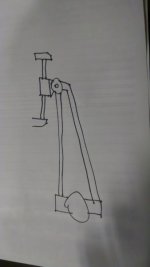Ghostman
24v crazy
- Joined
- Aug 24, 2012
- Messages
- 2,819
So I have this idea for some traction bars that is pretty fresh I think. As we can all agree that on a leaf spring suspension setup the axle moves up and down in along an elliptical line. As the axle moves up the springs lengthen and the shackle moves rearward and as the axle droops the shackle moves forward and springs get shorter.
So therefore any 2 bar traction setup with fixed mounting points will have inherent bind on suspension components unless it follows the same arc as the axle which is practically impossible.
I know if you run them long and flat it helps and most people don't complain much and yes the probably cause less bind than what axle wrap causes but I'm just had an idea I thought might work.
Don't mention the ladder bar setup either with a swing shackle because it causes pinion rotation as well.
So here's my thought. Make the bars long and flat like usual. Have a fixed mounting point on the axle side. Now on the frame side use a type of bushing out of uhmw material and capture it in a slide similar to what leaf spring sliders look like. At ride height you would adjust it to where the bar is bottomed out forward, as in it cannot slide forward. But it would have the option to slide back a couple inches when the axle travels up and down.
Any smart suspension guys out there think this would work?
Sent from my iPhone using Tapatalk
So therefore any 2 bar traction setup with fixed mounting points will have inherent bind on suspension components unless it follows the same arc as the axle which is practically impossible.
I know if you run them long and flat it helps and most people don't complain much and yes the probably cause less bind than what axle wrap causes but I'm just had an idea I thought might work.
Don't mention the ladder bar setup either with a swing shackle because it causes pinion rotation as well.
So here's my thought. Make the bars long and flat like usual. Have a fixed mounting point on the axle side. Now on the frame side use a type of bushing out of uhmw material and capture it in a slide similar to what leaf spring sliders look like. At ride height you would adjust it to where the bar is bottomed out forward, as in it cannot slide forward. But it would have the option to slide back a couple inches when the axle travels up and down.
Any smart suspension guys out there think this would work?
Sent from my iPhone using Tapatalk

